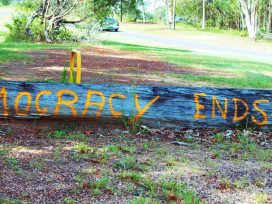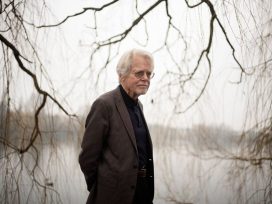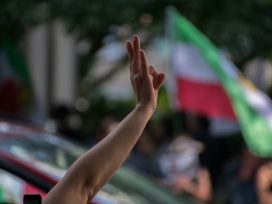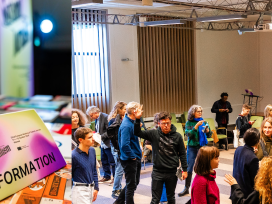It has been three years since the Iranian Spring, yet its aftershocks are still strongly reverberating in Iran and in the world. With hindsight, the Iranian civic movement of June 2009 stands out as a pivotal moment in modern Iranian history. What started as an uprising against the rigged presidential elections and the re-election of Mahmoud Ahmadinejad turned into a mass struggle for civil liberties and the removal of the theocratic regime in Iran. The demonstrations were not simply a reaction to the unfair election but were based on years of built up frustration, dissatisfaction and anger at the repressive rule of the Islamic Republic. As a young, nonviolent and civil movement for change within Iranian society, the Green Movement was an historic battle for the establishment of an accountable and lawful government. As the movement developed, it became increasingly clear that the fraudulent elections had given the Iranian people an opportunity not only to defend what few democratic rights they had, but also to attempt to lay the new foundations for a truly democratic Iran. The more the Green Movement grew and gained momentum, the closer the Islamic Republic seemed to crumbling and coming to an abrupt end.
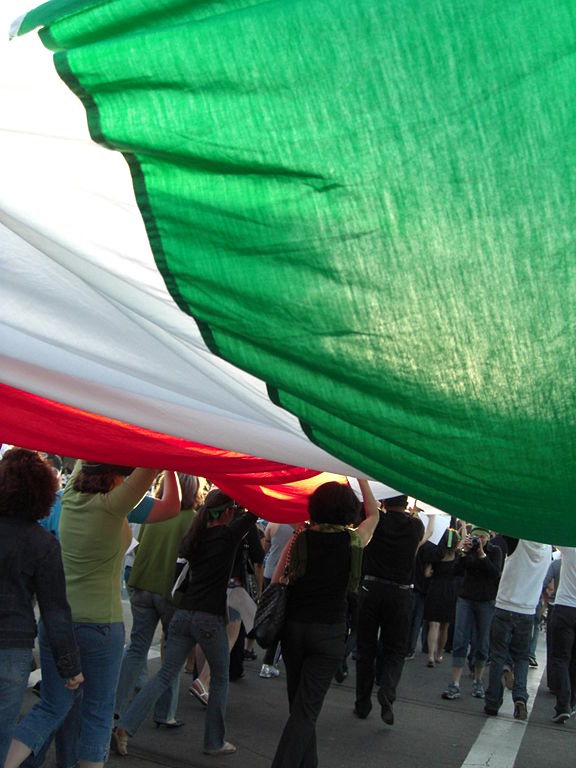
Photo: Mike Palmer/Wikimedia CC.
It is important to highlight that the Green Movement, specifically with regard to its democratic beliefs, did not suddenly materialize in the aftermath of the fraudulent elections. Over the past 20 years Iran has been going through a major political and societal evolution, as its increasingly young population became more educated, secular and liberal. This generational gap has divided Iranian society between essentially conservative and reformist groups and brought liberal ideals to the forefront of political discussions. The Green Movement was arguably a manifestation of the changing political, social and cultural attitudes that have been slowly emerging among Iran’s intellectuals, students, women activists and its young population generally.
Ever since the first days of the Islamic revolution, two incompatible and conflicting conceptions of sovereignty have tended to define the ideological contours of the political power struggle between contending forces in Iran. The mass protests of June 2009 were the largest since the student-led demonstrations of summer 1999. But the Green Movement was the first time since the revolution of 1979 that different sectors of Iranian society – religious and secular, old and young, poor and rich – took to the streets en masse. This shows clearly that the role of Iranian civil society in the process of political and social change in the three previous decades evolved from an ad hoc strategy associated with feminist, intellectual or student dissent into a more reflective and organized method of struggle. Indeed, the past twenty years have witnessed a remarkable upsurge in nonviolent thinking and civic action against autocratic rule in Iran. Civil society and nonviolent action, more than any other topics, have been the subject of intense debate and contention in recent decades.
What became clear with the Green Movement was that the Iranian political structure was facing a crisis of legitimacy and that the current power holders had lost moral credibility because of their cruelty and lies. By asserting the republican principle of popular sovereignty, the Green Movement asserted an alternative source of legitimacy against the political theology of the absolute sovereignty of the Supreme Leader.
In addition, most of the demonstrators who questioned the legitimacy of Iran’s electoral process belonged to a new generation who had not experienced, or were too young to remember, the revolution of 1979. They made up one-third of eligible voters in the Iranian presidential election. The movement was a forceful reminder of the fact that a monolithic image of Iran did not reflect the mindset of the 70 per cent of the population under the age of 30. Young Iranians’ quest for democracy presented serious challenges not only to the status and legitimacy of the doctrine of the Velayat-e Faqih (Guardianship of the Jurist), but also to the reform movement and its democratic authenticity.
Ironically, the Green Movement paralleled two strategies used in the 1979 Islamic revolution: nonviolence and the use of communications technologies. In 1979, Iranian revolutionaries used cassette tapes to circulate Khomeini’s speeches clandestinely. In 2009, Facebook and Twitter became the media of choice for young protestors. Nonviolence was used by protestors to express their concerns and to show the government that they did not want to retaliate against the violence of the paramilitary forces of the Basij. Many young students and activists believed that nonviolence was the only way to achieve peace and democracy. The movement, without a doubt, had the capacity to resort to violence in order to counter the brutality of the regime; yet this did not occur. The demonstrators were determined and encouraged to seek some sort of dialogue with the state rather than plunging the country into another period of bloodshed.
Another possible reason for the Green Movement’s nonviolent nature is the fact that many Iranians, specifically the younger generation, have moved away from the ideological worldviews of Marxism-Leninism and radical Islamism, responsible for much of the violence that occurred in the first years after the revolution of 1979. The Iranian Revolution of February 1979 was a great socio-political change accompanied by a hybrid intellectual discourse; but it was incontrovertibly not an intellectual shift towards a critique of violence. On the contrary, it heralded the return of massive and long-term violence to modern Iranian politics. Younger generations in Iran find it hard to believe that Ayatollah Khomeini succeeded in establishing a violent theocracy in Iran in the latter decades of the twentieth century in a violent setting framed and normalized by Mohammad Reza Shah and his Marxist opponents. Looking back, one needs to emphasize that Khomeini, unlike the Iranian leftists, did not romanticize violence but practiced it in an unbending manner against his enemies. To rephrase George Orwell: Ayatollah Khomeini and his followers did not establish an Islamic theocracy in order to safeguard a revolution; they staged a revolution in order to establish an Islamic theocracy. But in doing so, they took the genie of violence out of the bottle, a genie put back (at least in spirit) thirty years later by the Green Movement of 2009.
Another effect and accomplishment of the Green Movement was that it intensified the divisions within the regime. It revealed the “deep fissures” that existed between factional and ideological groups within the Islamic Republic. The Supreme Leader was no longer seen as the “neutral arbiter” of the state and lost legitimacy in the eyes of many Iranians. It became apparent that the state was not invincible but internally unstable, riddled with conflicts regarding its future direction. As a result of the Green Movement, the divide between the Iranian state and Iranian civil society became deeper than ever. It also created a gap between those who believe that normal economic and political relations with the West are vital to Iran’s future, and those who disdain such relations as violations of the revolution’s ideals. The striking contrast between Mir Hossein Mousavi, the reformist presidential candidate, and Mahmoud Ahmadinejad showed that the regime was struggling with how to handle an overwhelmingly young population that is becoming less religious and more modern and progressive.
Unfortunately, the regime did not seek to engage diplomatically with the protestors but instead answered with a ferocious campaign of brutal repression that aimed to kill, injure, intimidate, imprison or torture whoever stood in its way. After several months of protest, the price of speaking truth to power turned out to be higher than Iranian civic actors had expected. There were mass arrests, Stalinist-style show trials, torture, rape and murder.
Also, the nature of Iran’s system, with its power split between two centres – the president and the Supreme Leader – has complicated and slowed down the process of change. The highest office within the Iranian political structure is that of Supreme Leader, which is currently held by Ayatollah Khomeini’s successor, Ayatollah Ali Khamenei. Khamenei is responsible for delineation and supervision of “the general policies of the Islamic Republic of Iran”, meaning that he sets the tone and direction of Iran’s domestic and foreign policies. He is the commander-in-chief of the armed forces and controls the intelligence and security apparatus. He has the power to appoint and dismiss the leaders of the judiciary and the state broadcasting networks as well as the supreme commander of the Revolutionary Guards. He also appoints six of the twelve members of the Council of Guardians. The Council of Guardians is vested with the authority to interpret the constitution and determines if the laws passed by the Parliament are in line with the Shari’a. Hence, he has a veto power over the Parliament. The Council also examines presidential and parliamentary candidates to determine their fitness to run for a seat. In the latest presidential elections, only 8 of over 2000 candidates were allowed on the ballot.
The Assembly of Experts, which meets for one week every year, elects the Supreme Leader, but it also supervises the activities of the Leader and all the organizations controlled by his office. The assembly consists of 86 “virtuous and learned” clerics elected by the public to eight-year terms. Many analysts compare the Assembly of Experts to the Vatican’s College of Cardinals. The President is the second highest-ranking figure in Iran. Elected by popular vote to a four-year term, the President appoints and supervises the Cabinet and coordinates government decisions. The President is also responsible for setting the country’s economic policies, but does not control the armed forces. As a matter of fact, though the President has a nominal authority over the Supreme National Security Council and the Ministry of Intelligence, in practice the Supreme Leader controls all matters of security. In other words, the Supreme Leader and institutions related to him have unhindered power in Iran. Hence it is not surprising that the Iranian Green Movement of June 2009 radicalized its slogans from “Where is my Vote” to “Down with Velayat-e Faqih“.
Despite the brutal put-down, the Green Movement achieved its goal by gaining the moral high ground, revealing to the world the true face of the Islamic regime and draining away much of its domestic legitimacy. Further, by exposing the existing political rifts within the Iranian political regime, it has hastened the end of Khomeini’s ideology of the absolute guardianship of the jurist. The regime had no trouble finding ways to kill or attack its own citizens, and even used snipers to target unarmed protestors. Neda Agha-Soltan, one innocent protestor who was shot and killed by a sniper, soon became “a powerful symbol of the cruelty” of the Islamic Republic. Despite the violence of the regime, the movement remained nonviolent and peaceful and Iranians increasingly came to embrace this mindset. The fact that the Green Movement, with so many different groups under its banner, including intellectuals, student movements and women’s rights movements, was capable and determined to adopt and embracing a nonviolent stance was a truly great achievement. This was a rare instance in modern Iranian history of the massive use of nonviolent civil disobedience, indicating a shift in Iran’s political consciousness and culture.
In conclusion, we need to ask the question: where does Iran’s Green Movement stand three years later? It is true that the movement has lost much of its strength and mobilizing capacity inside Iran, while the Arab Spring has toppled regimes across the region. Had the Green Movement’s leadership been stronger and more determined, they may have been able to tip the scales in their favour by undermining the bases of the rentier state. However, the hesitation and reluctance of opposition candidates Mir-Hossein Mousavi and Mehdi Karroubi allowed the state to slowly render them ineffective through sheer force, threats and house arrest. The movement, however, is alive as a potential for civil change, inside and outside Iran, and its leadership has shifted from being centralized to being multi-centred, and is effectively represented by all the dissidents who are now living in exile. Many believe that the Green Movement has lost its unity and its momentum because of the violent crackdown by the Iranian regime. Others would say that it had the potential to accomplish almost anything, yet it was held back and ultimately underperformed due to its biggest weakness: its leadership.
Consequently, the Green Movement employed a limited range of tactics against the state: street protests turned out to be the its main weapon, Instead, the Green Movement should have enlisted the support of key segments of the Iranian economy, which would have included major industries, transportation and worker unions, government employees, bazaar merchants, and most importantly, oil workers. But although though the Green Movement failed to overcome the Islamic Republic politically, it was by no means an all-out failure. It managed not only to make an impact on Iranian politics and political culture, but also further delegitimized the Islamic Republic. The protests and demonstrations also showcased the democratic maturity of the Iranian people, who were willing to risk their lives in order to defend what little democratic rights they had. The republican principle of popular sovereignty is what led the social and political actors of the Green Movement to challenge Ayatollah Khamenei’s authoritarian methods of governance. It let the genie of democracy out of the bottle, and the Iranian regime clearly fears that it won’t be able to drive it back.


